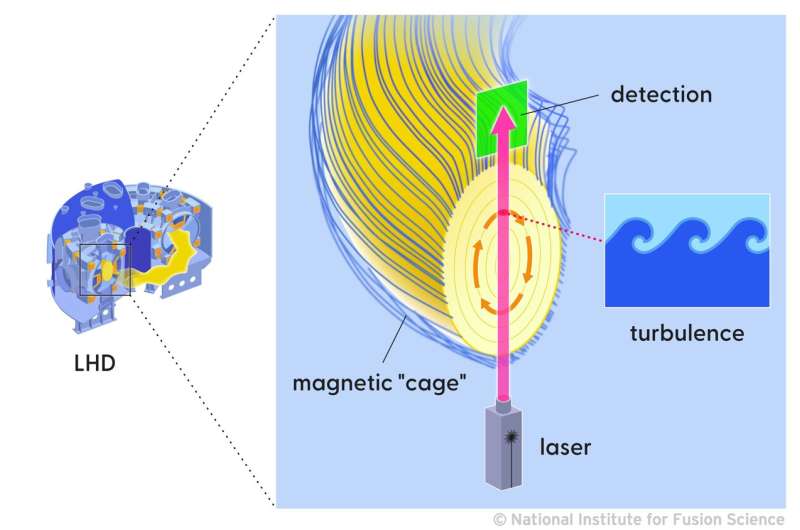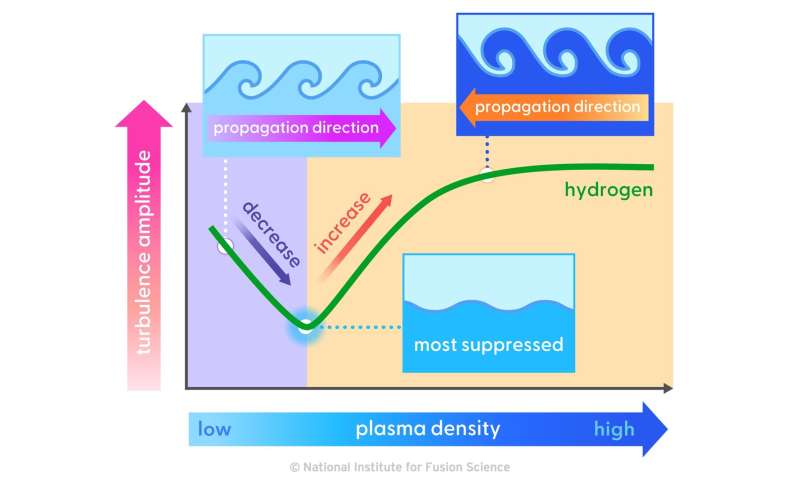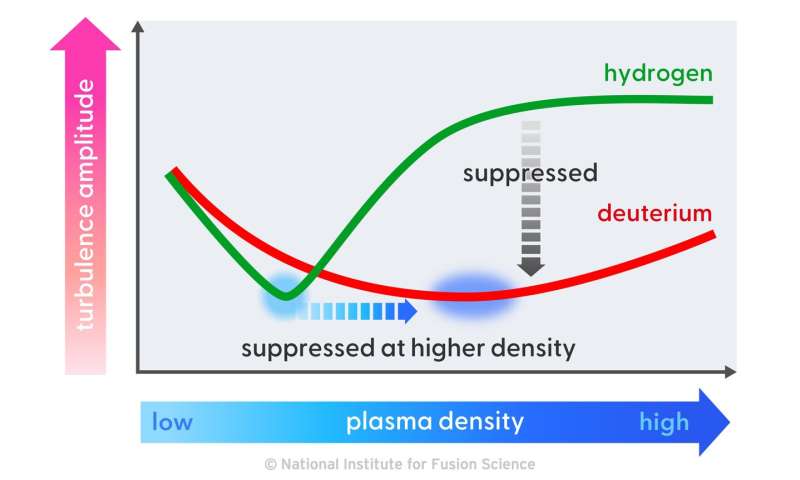This article has been reviewed according to Science X's editorial process and policies. Editors have highlighted the following attributes while ensuring the content's credibility:
fact-checked
peer-reviewed publication
trusted source
proofread
The discovery of new turbulence transition in fusion plasmas

Fusion energy is released when two light nuclei combine to form a single heavier one (nuclear fusion reaction). Fusion energy-based power generation (fusion power plant) uses the energy generated when deuterium and tritium combine to form helium.
A nuclear fusion reaction does not produce carbon dioxide. In addition, since it is possible to extract deuterium and tritium from the sea water, fusion energy is regarded as a sustainable energy source, and research into its practical application has been progressing rapidly in recent years.
To initiate a fusion reaction, deuterium and tritium must be heated to over 100 million degrees Celsius to form plasma, which is then maintained by a strong magnetic "cage." However, when turbulence is excited in the plasma, the plasma flows out of the magnetic "cage."
Therefore, turbulence is an important topic in fusion research, and its suppression is essential to the realization of a fusion power plant. For turbulence suppression, an understanding of the physical mechanism of turbulence excitation is essential, and LHD is the perfect device to tackle this challenge.
For example, turbulence measurement is generally not easy, but researchers have successfully measured not only its amplitude but also its spatial profile and propagation direction using precision laser diagnostics. Moreover, these series of experiments were conducted during a period of deuterium experimentation (2017–2022) in LHD, and the ion-mass dependence of turbulence was investigated.
A research group led by Assistant Professor Toshiki Kinoshita (Research Institute for Applied Mechanics, Kyushu University), Professor Kenji Tanaka (National Institute for Fusion Science, National Institutes on Natural Sciences) and Professor Akihiro Ishizawa (Graduate School of Energy Science, Kyoto University) and others performed experiments in which the density (amount of electrons and ions) of the hydrogen plasma was changed under identical heating conditions to gain a comprehensive understanding of turbulence in LHD.
Their paper is published in the journal Physical Review Letters.
At the same time, the turbulence was measured in detail. As a result, it was found that turbulence is most suppressed at a certain density (transition density), and below the transition density, it decreases with increasing density, but above the transition density, it begins to increase. Furthermore, it was observed that the turbulence propagation direction reverses after the transition density. This result implies that the turbulence nature changes around the transition density (turbulence transition).
-

Relation between density and turbulence. Credit: National Institute for Fusion Science -

Differences of turbulence behavior between hydrogen and deuterium plasmas. Credit: National Institute for Fusion Science
Then, to corroborate the turbulence transition, simulations were performed on the Raijin supercomputer. As a result, the researchers found that the turbulence observed below the transition density was mainly caused by the ion-temperature gradient, while that above it was mainly caused by the pressure gradient and plasma resistivity.
Moreover, they identified that this change in the turbulence is an important physical mechanism of turbulence suppression. Thus, by making full use of experiments and simulations, they revealed that the observed turbulence suppression was due to a change in the turbulence mode, i.e., turbulence transition.
In addition, experiments under the same conditions were conducted in deuterium plasmas and compared with hydrogen plasmas. As a result, they found that turbulence transitions occur at higher density for the deuterium plasma, i.e., turbulence is suppressed at higher density.
Furthermore, surprisingly, the turbulence observed above the transition density is clearly suppressed in deuterium plasmas. The turbulence suppression observed at high density in deuterium plasmas implies that it will be further suppressed in the higher-density and heavier-mass deuterium/tritium mixture plasmas envisioned for fusion power generation. This is a favorable result for early realization of fusion power generation.
This study shows that turbulence is most suppressed during the turbulence transition and the turbulence transition density is higher in deuterium plasmas than in hydrogen plasmas. The different transition densities mean that turbulence transition condition is not determined solely by electron density.
The next step is to identify the turbulence transition condition based on the physical background of turbulence, and to develop innovative operation scenarios with low-turbulence conditions for fusion power plants.
The researchers say they would also like to extend their research into an extrapolation to deuterium/tritium mixed plasmas and their application to plant design in order to find efficient solutions for realizing fusion energy.
More information: T. Kinoshita et al, Turbulence Transition in Magnetically Confined Hydrogen and Deuterium Plasmas, Physical Review Letters (2024). DOI: 10.1103/PhysRevLett.132.235101
Journal information: Physical Review Letters
Provided by National Institutes of Natural Sciences





















